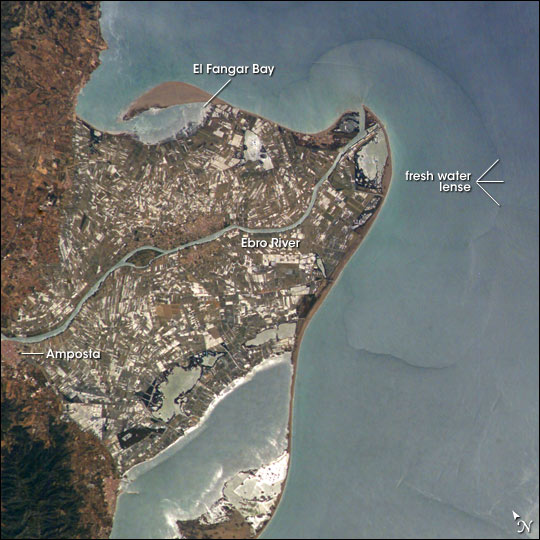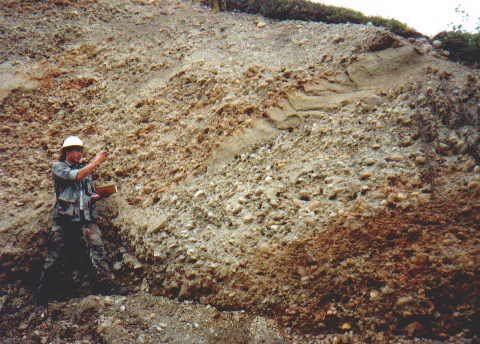|
Aggradation
Aggradation (or alluviation) is the term used in geology for the increase in land elevation, typically in a river system, due to the deposition of sediment. Aggradation occurs in areas in which the supply of sediment is greater than the amount of material that the system is able to transport. The mass balance between sediment being transported and sediment in the bed is described by the Exner equation. Typical aggradational environments include lowland alluvial rivers, river deltas, and alluvial fans. Aggradational environments are often undergoing slow subsidence which balances the increase in land surface elevation due to aggradation. After millions of years, an aggradational environment will become a sedimentary basin, which contains the deposited sediment, including paleochannels and ancient floodplains. Aggradation can be caused by changes in climate, land use, and geologic activity, such as volcanic eruption, earthquakes, and faulting. For example, volcanic eruption ... [...More Info...] [...Related Items...] OR: [Wikipedia] [Google] [Baidu] |
Exner Equation
The Exner equation is a statement of conservation of mass that applies to sediment in a fluvial system such as a river. It was developed by the Austrian meteorologist and sedimentologist Felix Maria Exner, from whom it derives its name. The equation The Exner equation describes conservation of mass between sediment in the bed of a channel and sediment that is being transported. It states that bed elevation increases (the bed aggrades) proportionally to the amount of sediment that drops out of transport, and conversely decreases (the bed degrades) proportionally to the amount of sediment that becomes entrained by the flow. Basic equation The equation states that the change in bed elevation, \eta, over time, t, is equal to one over the grain packing density, \varepsilon_o, times the negative divergence of sediment flux, q_s. : \frac = -\frac\nabla\cdot\mathbf Note that \varepsilon_o can also be expressed as (1-\lambda_p), where \lambda_p equals the bed porosity. Good values o ... [...More Info...] [...Related Items...] OR: [Wikipedia] [Google] [Baidu] |
River
A river is a natural flowing watercourse, usually freshwater Fresh water or freshwater is any naturally occurring liquid or frozen water containing low concentrations of dissolved salts and other total dissolved solids. Although the term specifically excludes seawater and brackish water, it does include ..., flowing towards an ocean, sea, lake or another river. In some cases, a river flows into the ground and becomes dry at the end of its course without reaching another body of water. Small rivers can be referred to using names such as Stream#Creek, creek, Stream#Brook, brook, rivulet, and rill. There are no official definitions for the generic term river as applied to Geographical feature, geographic features, although in some countries or communities a stream is defined by its size. Many names for small rivers are specific to geographic location; examples are "run" in some parts of the United States, "Burn (landform), burn" in Scotland and northeast England, and "be ... [...More Info...] [...Related Items...] OR: [Wikipedia] [Google] [Baidu] |
Paleochannel
A palaeochannel, also spelt paleochannel and also known as palaeovalley or palaeoriver, is a geological term describing a remnant of an inactive river or stream channel that has been filled or buried by younger sediment. The sediments that the ancient channel is cut into or buried by can be unconsolidated, semi-consolidated, consolidated or lithified. The word ''palaeochannel'' is formed from the ''palaeo'', meaning "old," and ''channel''. Recognition A palaeochannel is distinct from the overbank deposits of currently-active river channels, including ephemeral water courses that do not regularly flow (such as the Todd River, Central Australia) because the river bed is filled with sedimentary deposits unrelated to the normal bed load of the current drainage pattern. Many palaeochannels are arranged on old drainage patterns, distinct from the current drainage system of a catchment. For example, palaeochannels may relate to a system of rivers and creeks that drained east– ... [...More Info...] [...Related Items...] OR: [Wikipedia] [Google] [Baidu] |
River Delta
A river delta is a landform shaped like a triangle, created by deposition of sediment that is carried by a river and enters slower-moving or stagnant water. This occurs where a river enters an ocean, sea, estuary, lake, reservoir, or (more rarely) another river that cannot carry away the supplied sediment. It is so named because its triangle shape resembles the Greek letter Delta. The size and shape of a delta is controlled by the balance between watershed processes that supply sediment, and receiving basin processes that redistribute, sequester, and export that sediment. The size, geometry, and location of the receiving basin also plays an important role in delta evolution. River deltas are important in human civilization, as they are major agricultural production centers and population centers. They can provide coastline defense and can impact drinking water supply. They are also ecologically important, with different species' assemblages depending on their landscape posi ... [...More Info...] [...Related Items...] OR: [Wikipedia] [Google] [Baidu] |
Floodplain
A floodplain or flood plain or bottomlands is an area of land adjacent to a river which stretches from the banks of its channel to the base of the enclosing valley walls, and which experiences flooding during periods of high discharge.Goudie, A. S., 2004, ''Encyclopedia of Geomorphology'', vol. 1. Routledge, New York. The soils usually consist of clays, silts, sands, and gravels deposited during floods. Because the regular flooding of floodplains can deposit nutrients and water, floodplains frequently have high soil fertility; some important agricultural regions, such as the Mississippi river basin and the Nile, rely heavily on the flood plains. Agricultural regions as well as urban areas have developed near or on floodplains to take advantage of the rich soil and fresh water. However, the risk of flooding has led to increasing efforts to control flooding. Formation Most floodplains are formed by deposition on the inside of river meanders and by overbank flow. Wherev ... [...More Info...] [...Related Items...] OR: [Wikipedia] [Google] [Baidu] |
Alluvial
Alluvium (from Latin ''alluvius'', from ''alluere'' 'to wash against') is loose clay, silt, sand, or gravel that has been deposited by running water in a stream bed, on a floodplain, in an alluvial fan or beach, or in similar settings. Alluvium is also sometimes called alluvial deposit. Alluvium is typically geologically young and is not consolidated into solid rock. Sediments deposited underwater, in seas, estuaries, lakes, or ponds, are not described as alluvium. Floodplain alluvium can be highly fertile, and supported some of the earliest human civilizations. Definitions The present consensus is that "alluvium" refers to loose sediments of all types deposited by running water in floodplains or in alluvial fans or related landforms. However, the meaning of the term has varied considerably since it was first defined in the French dictionary of Antoine Furetière, posthumously published in 1690. Drawing upon concepts from Roman law, Furetière defined '' alluvion'' ( ... [...More Info...] [...Related Items...] OR: [Wikipedia] [Google] [Baidu] |
Earthquake
An earthquake (also known as a quake, tremor or temblor) is the shaking of the surface of the Earth resulting from a sudden release of energy in the Earth's lithosphere that creates seismic waves. Earthquakes can range in intensity, from those that are so weak that they cannot be felt, to those violent enough to propel objects and people into the air, damage critical infrastructure, and wreak destruction across entire cities. The seismic activity of an area is the frequency, type, and size of earthquakes experienced over a particular time period. The seismicity at a particular location in the Earth is the average rate of seismic energy release per unit volume. The word ''tremor'' is also used for Episodic tremor and slip, non-earthquake seismic rumbling. At the Earth's surface, earthquakes manifest themselves by shaking and displacing or disrupting the ground. When the epicenter of a large earthquake is located offshore, the seabed may be displaced sufficiently to cause ... [...More Info...] [...Related Items...] OR: [Wikipedia] [Google] [Baidu] |
Geomorphology
Geomorphology (from Ancient Greek: , ', "earth"; , ', "form"; and , ', "study") is the scientific study of the origin and evolution of topographic and bathymetric features created by physical, chemical or biological processes operating at or near Earth's surface. Geomorphologists seek to understand why landscapes look the way they do, to understand landform and terrain history and dynamics and to predict changes through a combination of field observations, physical experiments and numerical modeling. Geomorphologists work within disciplines such as physical geography, geology, geodesy, engineering geology, archaeology, climatology, and geotechnical engineering. This broad base of interests contributes to many research styles and interests within the field. Overview Earth's surface is modified by a combination of surface processes that shape landscapes, and geologic processes that cause tectonic uplift and subsidence, and shape the coastal geography. Surface proc ... [...More Info...] [...Related Items...] OR: [Wikipedia] [Google] [Baidu] |
David Mohrig
David Mohrig is an American professor of geology and geomorphology whose works have been published in such journals as the Geological Society of America Bulletin, Journal of Hydraulic Engineering and many others. Currently he works at Jackson School of Geosciences of Austin, Texas Austin is the capital city of the U.S. state of Texas, as well as the county seat, seat and largest city of Travis County, Texas, Travis County, with portions extending into Hays County, Texas, Hays and Williamson County, Texas, Williamson co .... References External linksDavid Mohrig Living people 20th-century births American geologists Year of birth missing (living people) {{US-geologist-stub ... [...More Info...] [...Related Items...] OR: [Wikipedia] [Google] [Baidu] |
BBC News Online
BBC News Online is the website of BBC News, the division of the BBC responsible for newsgathering and production. It is one of the most popular news websites, with 1.2 billion website visits in April 2021, as well as being used by 60% of the UK's internet users for news. The website contains international news coverage, as well as British, entertainment, science, and political news. Many reports are accompanied by audio and video from the BBC's television and radio news services, while the latest TV and radio bulletins are also available to view or listen to on the site together with other current affairs programmes. BBC News Online is closely linked to its sister department website, that of BBC Sport. Both sites follow similar layout and content options and respective journalists work alongside each other. Location information provided by users is also shared with the website of BBC Weather to provide local content. From 1998 to 2001 the site was named best news website at ... [...More Info...] [...Related Items...] OR: [Wikipedia] [Google] [Baidu] |
Nature Geoscience
''Nature Geoscience'' is a monthly peer-reviewed scientific journal published by the Nature Publishing Group. The Chief Editor is Tamara Goldin, who took over from Heike Langenberg in February 2020. It was established in January 2008. Scope The journal covers all aspects of the Earth sciences, including theoretical research, modelling, and field work. Significant related work in other fields, such as atmospheric sciences, geology, geophysics, climatology, oceanography, palaeontology, and space science, is also published. Abstracting and indexing The journal is abstracted and indexed by: * ''CAB Abstracts'' * ''Chemical Abstracts Service/ CASSI'' * ''Science Citation Index'' * ''Current Contents/Physical, Chemical & Earth Sciences'' * ''GeoRef'' According to the ''Journal Citation Reports'', the journal has a 2020 impact factor The impact factor (IF) or journal impact factor (JIF) of an academic journal is a scientometric index calculated by Clarivate that reflect ... [...More Info...] [...Related Items...] OR: [Wikipedia] [Google] [Baidu] |





